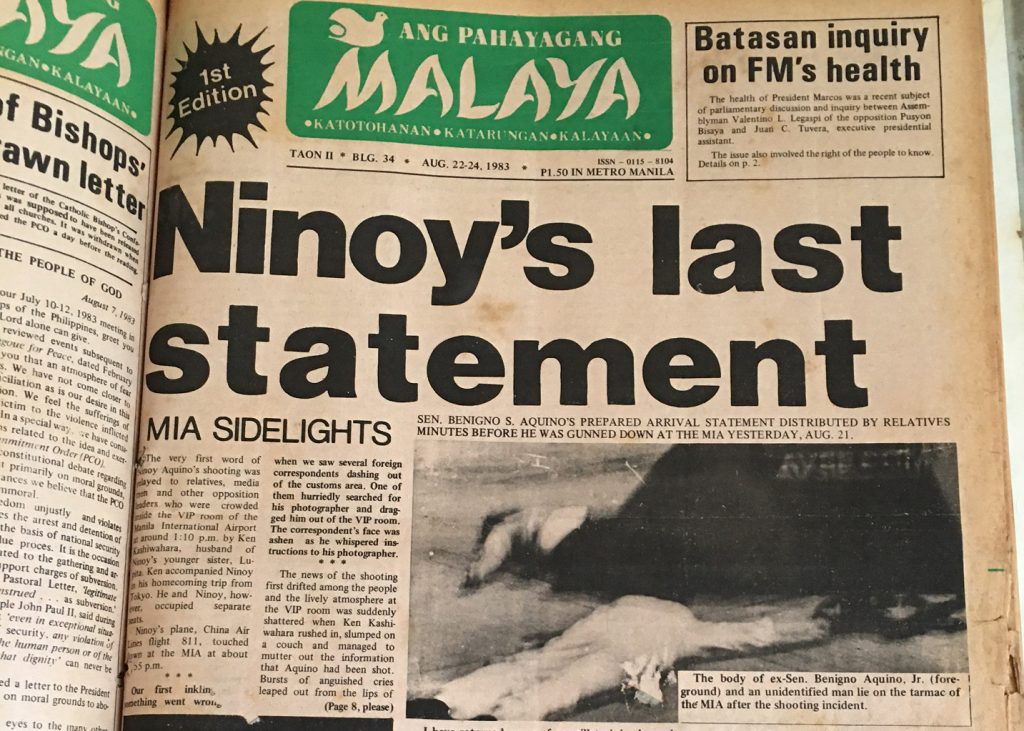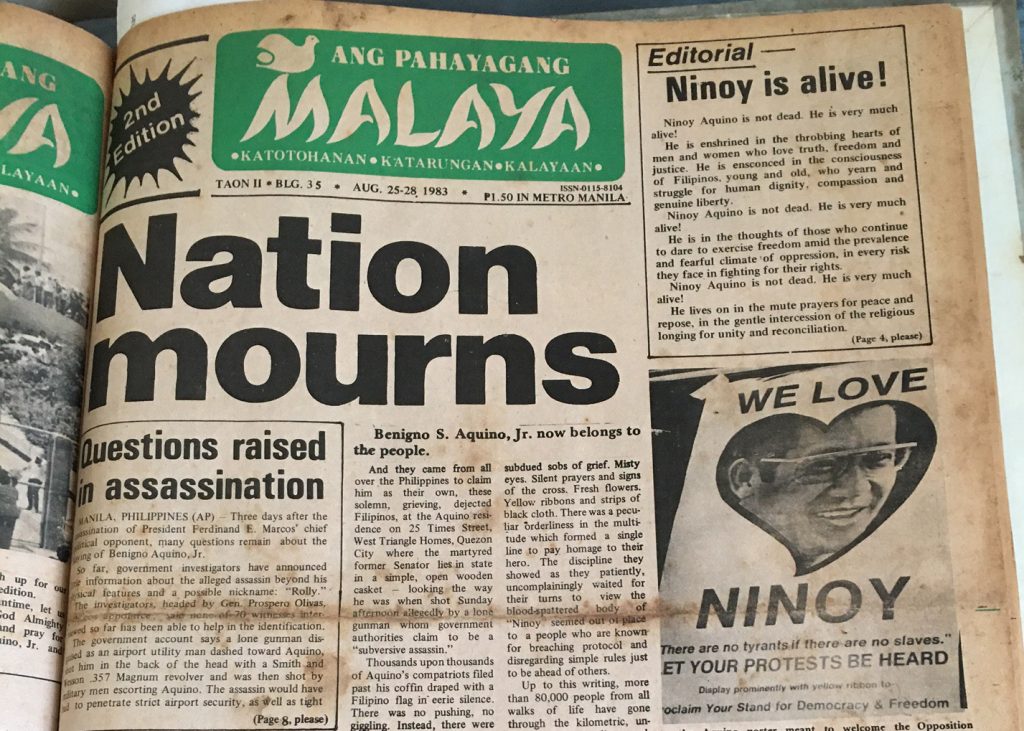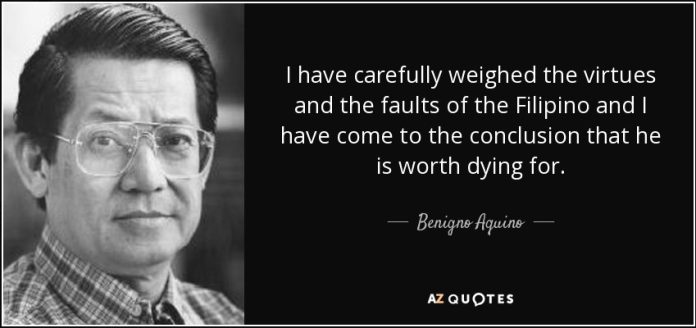Today, August 21, as the nation remembers the man who came home in peace to find peace, “in the manner of Gandhi,” but was met with a violent death and didn’t find it, allow me to recall what “Ang Pahayagang Malaya” of the late Jose G. Burgos Jr. reported of the martyrdom.
In a fashion, this would be honoring the martyr Ninoy Aquino and the newspaper “Malaya,” which did its duty of letting the people know.
Joe was a part of the group who planned and organized the welcome that “should-have-been” — yellow ribbons and all — so he was at the VIP room of the Manila International Airport with relatives and close friends waiting for Ninoy to disembark.
When the brutal shooting happened, he witnessed the panic, grief, mayhem that seized those who were in the room.
Captured in the piece “Excruciating Afternoon” were the moments of the afternoon of August 21, 1983.
“It was the most excruciating afternoon for me – that tragic Sunday, August 21. But I was not alone. Many, many others felt the same searing feeling of total dejection, pain and outrage upon hearing the shocking news of Ninoy Aquino’s brutal assassination while being escorted by military men from his plane at the Manila International Airport.
“It was a most painful experience although I, too, have suffered oppression in a much lesser degree than what befell the Philippines’ No.1 dissenter and patriot.
“The feeling was exacerbated by the fact that after the brutal murder, I had to rush out of the MIA to the office to beat a self-imposed deadline of 6:00 o’clock, re-layout the entire front page of MALAYA and have the photographs I took portraying both the joy and the gloom, the exhilaration and the depression, of Ninoy’s arrival, developed.
“I have had tighter schedules in the past when I was with the Manila Times-Daily Mirror-Taliba chain of newspapers. In fact, I managed to crank out a story after facing the muzzles of armalite rifles during the infamous confrontation in Ilocos Sur in 1969. But terror and nervousness were easily shucked by the professional desire to write the story and see it printed so the public may know.
“But how can one organize one’s thought, steadily type out words that have to have meaning while at the same time, one’s emotion is swiftly being drained? How can one be indignant in the heart and at the same time, detached in the mind?

“I was in a frenzy that afternoon. But as twilight approached, numbness gave way to a fierce outburst of defiance against feeling to do a job one has to do, and do it fast, too.
“As I wrote the ‘MIA Sidelights.’ the mind subverted the heart but not for long. Radio Veritas, which had been religiously broadcasting live the tragedy of Ninoy’s sudden death interrupted its reporters’ live coverage and played “Ang Bayan Ko” in an obvious tribute to Ninoy. I was then typing out the lines about the estimated 10,000 exuberant welcomers when the haunting lyrics ‘Ibon man may layang lumipad, kulungin mo at umiiyak….” wafted through. Tears could not be held back, neither could the thoughts and the story.
“The deadline could not wait. The production people were waiting anxiously for pages 1 and 8 (which goes together in one single flat that fits the single, low-speed run-down offset press). As I finally wound up the story, proofread it together with the headline (Ninoy’s last statement) and approved the pages, the heavens suddenly broke open, letting loose torrential rains as if it too, wanted to commiserate with those Ninoy had left behind.
“With the final paste-up in tow, I frantically drove to the Quezon City press, barely meeting the production deadline.
“The press finally rolled at 10:00 p.m. and the first issues were on Metro Manila’s streets shortly after 6 o’clock the following morning.
“I had fulfilled my duty to the public who were entitled to know.”
“The only newspaper that day — and even at the time of this writing — which published in full Ninoy Aquino’s arrival was ‘Ang Pahayagang Malaya.’
“It was my most excruciating afternoon. But things had to be done.” (Publisher’s Notes, Malaya Aug. 25-28, 1983)
For the first and only time in their lives, the children witnessed their father shed tears. As we, the kids and myself, kept a distance, respecting their father’s grief, I feared for the typewriter, which Joe pounded so hard that the keys seemed to be disassembled to pieces. The carriage threatened to fly off every time Joe pushed the release lever.

In its August 25-28, 1983, issue, Malaya’s editorial read:
Ninoy is Alive!
“Ninoy Aquino is not dead. He is very much alive!
“He is enshrined in the throbbing hearts of men and women who love truth, freedom and justice. He is ensconced in the consciousness of Filipinos, young and old, who yearn and struggle for human dignity, compassion and genuine liberty.
“Ninoy Aquino is not dead. He is very much alive!
“He is in the thoughts of those who continue to dare to exercise freedom amid the prevalence and fearful climate of oppression, in every risk they face in fighting for their rights.
“Ninoy Aquino is not dead. He is very much alive!
“He lives on in the mute prayers for peace and repose, in the gentle intercession of the religious longing for unity and reconciliation.
“Ninoy Aquino is not dead. He is very much alive!
“His spirit tightens the clenched fists of defiant youthful militants crying out against corruption and disregard for the people’s welfare and in the clasped hands of the more conservative who could only pray for fortitude to bear all the wickedness and the wrong-doings they see going on unabated in public and private institutions.
“Ninoy Aquino is not dead. He is very much alive!
“His ideals remain in every exercise of righteousness, in every single act of patriotism performed without fear by those who place the country’s welfare above any other consideration.
“Ninoy Aquino is not dead. He is very much alive!
“His dreams, hopes, and aspirations pulsate in the veins of relatives, close associates, friends and sympathizers, opting for change through non-violence and for the return of democracy, freedom and human rights to the Filipino people.
“Indeed, Ninoy Aquino is not dead. He can never be. He continues to be very much alive in all of us who are decided to seek and live the truth in the unifying spirit of love for people and country.
“Long live Ninoy Aquino.”
“The tree of liberty must be refreshed from time to time with the blood of patriots and tyrants. It is its natural manure. Our liberty depends on freedom of the press and that cannot be limited without being lost.” – Thomas Jefferson
Edita Burgos is a doctor of education and a member of the Secular Order of Discalced Carmelites. Gunmen — believed to be soldiers — abducted her son Jonas Burgos in Manila in April 2007. He is still missing. She was general manager of the publications WE Forum and Malaya.









